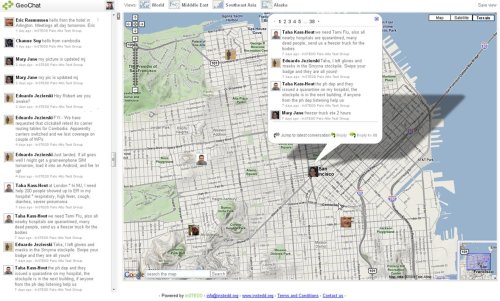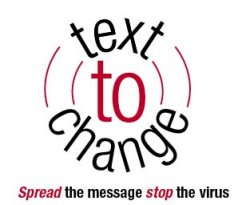Five amazing mobile projects
At the Web4Dev conference in New York I met with the founders, inventors and creators of some pretty amazing mobile-for-development projects. Below are my top five, with some thoughts on how they could be used for education.
 Ushahidi
Ushahidi
Ushahidi — which means “testimony” in Swahili — is a free, open-source platform to crowdsource crisis information. It allows anyone to submit information through SMS, email or web form, with each submission pinned to a map. The aggregate effect is a compelling visualisation of an event as it unfolds, told by citizen journalists. It has been used to report on the botched elections in Kenya, the DRC and the war in Gaza.
I told Erik Hersman, the White African behind Ushahidi, that it should be used for an alternate reality game with teenagers in Cape Town.
GeoChat
GeoChat supports relief workers after a major humanitarian crisis, when reliable team-based communication is critical but notoriously difficult to achieve. This open-source group communications technology lets team members interact to maintain shared geospatial awareness of who is doing what where — over any device, on any platform, over any network. According to Robert Kirkpatrick, of InSTEDD, it works like this:
- You register with GeoChat either online, by email, or by SMS.
- Create a new GeoChat group and invite your team members.
- Send messages to one another, or share them with the entire group.
- If you’re mobile using your cell phone, prefix a text message with your location — say your current address, or a latitude and longitude from a GPS - and GeoChat will place your icon on the map for online users to see.
Even those not on the ground, e.g. the support team back at UN headquarters, can visualize the remote team on the surface of a map and interact with them. GeoChat is nearing public Beta release.

GeoChat beta test
For educational purposes, this tool could be used by learners when mapping their community. Or for co-ordinating on-the-ground players, and distance players, during that alternate reality game!
Text to Change
In a pilot project in Uganda, Text to Change — an mhealth non-profit organisation — used an SMS-based quiz to raise awareness around HIV/AIDS. The quiz, which reached 15,000 subscribers, had two goals: i) to collect information, and ii) to promote voluntary counseling and testing (VCT). As an incentive to answer questions, free airtime was offered.
 The quiz allowed TTC to assess the rate of correct answers within certain socio-economic sectors; this information was passed to UNICEF to inform their interventions. The quiz also resulted in a 40% increase in the number of people who sought VCT. All in all, a very successful project!
The quiz allowed TTC to assess the rate of correct answers within certain socio-economic sectors; this information was passed to UNICEF to inform their interventions. The quiz also resulted in a 40% increase in the number of people who sought VCT. All in all, a very successful project!
Hajo van Beijma and I spoke about how TTC could be used in South Africa (SA) for education. Some ideas:
- Literacy development: Send out short stories via SMS, e.g. each chapter of the story is five SMSs. Then ask readers: questions about the chapter (to test comprehension) via simple multiple choice or free-form responses, or ask readers to summarise the chapter and SMS it back, or ask readers to write their responses to the chapter, e.g. what do you think should happen next?
- Learner needs assessment: send out quizzes about what subjects/concepts learners are struggling with, e.g. fractions in Mathematics. Provide this data to the Department of Education.
RapidSMS
RapidSMS is an SMS-based open-source monitoring and data collection platform developed by UNICEF’s Innovations and Development team. An SMS submitting quantitative data consists of a keyword followed by parameters, e.g. “User5889 2″ could be HIV-patient number 5889 reporting that she’s just taken her second dose of anti-retroviral medicine for the day. Qualitative data can also be submitted — ideal for when polling communities. The RapidSMS interface allows for editing and visualisation of the received data, as well as exporting it for spreadsheets.
As the UNICEF team, Evan Wheeler, Christopher Fabian and Erica Kochi said in their report on Innovation for Africa, “rather than hiring consultants for monthly visits to hundreds of schools to survey teacher attendance, why not visit once and teach children to send UNICEF a SMS on days their teacher is not present?”
Literacy Bridge
Literacy Bridge is a non-profit organisation with the goal of making knowledge accessible to people living in poverty. The bet of Cliff Schmidt — it’s founder — is on audio, and so he created the talking book: a low cost, ruggedised audio player/recorder. The device has awesome features, such as simple device-to-device copying (no PC or network needed), audio hyperlinking (e.g. to a glossary of terms used in the audio piece), and slow play for reading practice.
In Africa, many people have low-access or no-access to ICT. The talking book is perfect for empowering this audience.
The conference made it clear that crowd-sourcing, user participation, SMS and geospatial visualisation (mapping) of information are all red hot right now.



